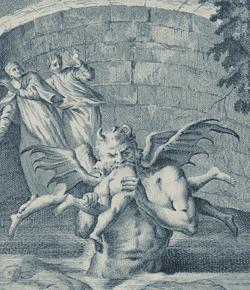|
|
Text and translation |
.gif)
|
"That man should speak at all is nature's act,
but how you speak-in this tongue or in that-
she leaves to you and to your preference."
(Adam to Dante, Paradiso XXVI, 130–132, trans. Mandelbaum)
|
The "visible language" of the sculptures
(Venice: Antonio Zatta, 1757). LA(80)
|
|
The first attempt at a critical edition of the Commedia was made at the end of
the sixteenth century by the Accademia della Crusca, which also produced the important
dictionary of the Italian language in 1612. In the seventeenth century, however,
there were only three editions of Dante. The eighteenth century saw a revival of interest
with thirty-two editions, and this accelerated throughout the nineteenth, which produced
more than 400 editions.
The oldest surviving printed translation of the Commedia is a Castilian version of the
Inferno from 1515. In English, the first published translation of the
Inferno was by Charles Rogers in 1782; the first translation of the
whole Commedia, by Henry Boyd,
was published in 1802. However, quotations from Dante in English can be traced back
as far as the works of Geoffrey Chaucer (d. 1400), who borrows from and alludes to
Dante - "the wise poete of Florence" - in several of his works.
|

|
|
.gif)
|
|
Lucifer chewing on the sinners (Venice: Antonio Zatta, 1757). LA(80)
|
|
The first printed translation of the Inferno (Burgos: Fadrique de Basilea, 1515). LA(65)
|
| |
 |
 |
 |
|
The sparkling circles of the heavenly host, Paradiso XXVIII. The vision of
Purgatory and Paradise, translated by the Rev. Henry Francis Cary, and
illustrated with the designs of Gustave Doré (London: Cassell, Petter,
and Galpin, [1869?]). CUL Eb.12.40 [item not on display]
|
Flaxman's illustration of the giant Antaeus carrying Virgil and Dante to
the lowest circle of Hell (London: Longman, Hurst, Rees, and Orme, 1807).
CUL LE.34.33 |
The first French translation of the Commedia, by Balthazar Grangier
(Paris: Georges Drobet, 1596; Jehan Gesselin, 1597). LA(66), Vol. 1
[item not on display] |
|
|
|